Consumer Price Index
Consumer Price Index (CPI) is the general measure of the change in the average retail prices of a market basket or collection of goods and services commonly purchased by the average Filipino household.
The CPI of the Cordillera Administrative Region (CAR) in February 2024 was 123.7. This was higher by 3.7 index points from the 120.0 CPI in February 2023 using 2018 as the base year.
In general, the CPI increased reflecting the rise in the average prices of goods and services in all six provinces and one highly urbanized city (HUC) of CAR.
Figure 1. Consumer Price Index by Province and HUC, CAR: February 2024
(2018=100)
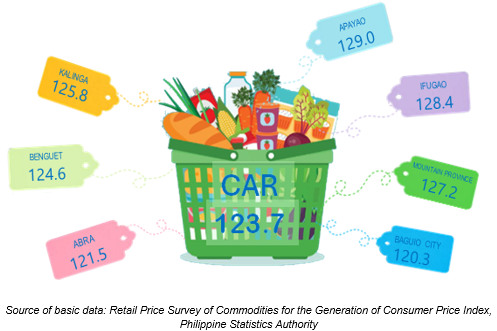
Among the CAR provinces and HUC, Apayao posted the highest CPI in February 2024 with 129.0 index points, followed by Ifugao with 128.4 index points, and Mountain Province with 127.2 index points. The provinces of Kalinga, Benguet, and Abra posted 125.8, 124.6, and 121.5 index points, respectively. Meanwhile, the City of Baguio recorded the lowest CPI with 120.3 index points.
CPI by Commodity Group
Among the commodity groups, Alcoholic Beverages and Tobacco had the highest CPI in the region with 153.9 index points in February 2024. Among the provinces, Kalinga incurred the highest CPI on this commodity with 183.5 index points followed by Abra, Mountain Province and Apayao with 173.0, 171.6, and 161.5 index points, respectively.
Financial Services posted the second highest CPI among the commodity groups with 136.8 index points. Among the provinces, Abra had the highest index on Financial Services with 159.2 index points while Ifugao and Mountain Province had the lowest with 75.0 index points.
Transport registered the third highest CPI with 134.6 index points. The province of Benguet recorded the highest index for this commodity with 156.2, followed by Apayao and Ifugao with 131.9 and 128.7 index points, respectively.
Information and Communication continued to incurred the lowest CPI among the commodity groups in the region during the month of February 2024 with 102.5 index points. The province of Apayao posted the highest index on Information and Communication with 103.4 index points while Ifugao and Mountain Province both had the lowest with 99.9 index points.
Figure 2. Consumer Price Index by Commodity Group and by Province and HUC,
CAR: February 2024
(2018=100)
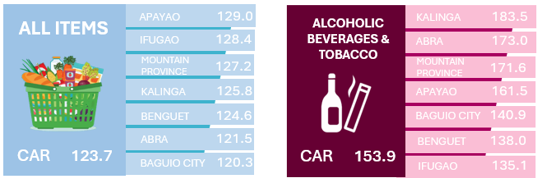
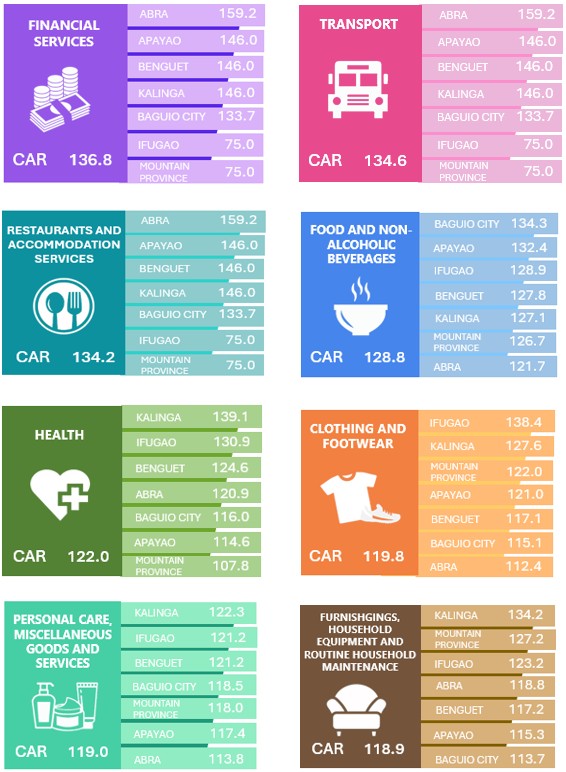
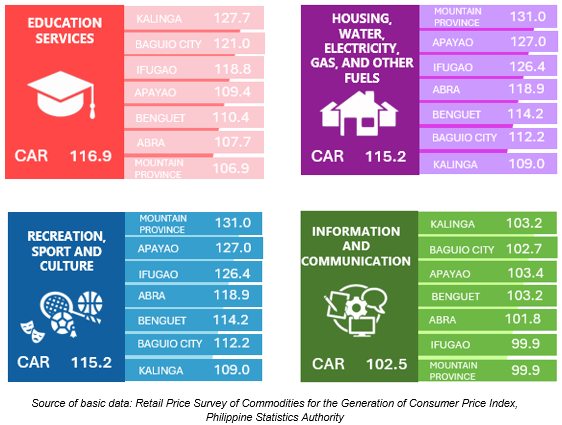
Meanwhile, the CPI of the heavily weighted Food and Non-Alcoholic Beverages ranked fifth among all commodity groups with 128.8 index points. Among the provinces and Highly Urbanized City (HUC), the City of Baguio recorded the highest index on Food and Non-Alcoholic Beverages with 134.3 index points. This was followed by Apayao, Ifugao, and Benguet with 132.4, 128.9, and 127.8 index points, respectively. On the other hand, the province of Abra incurred the lowest index on the commodity with 121.7.
By index point change, Education Services posted the highest increase with 8.9 points. This was followed by Alcoholic Beverages and Tobacco with an increase of 8.0 index points, and Restaurants and Accommodation Services with an increase of 6.4 index points. Meanwhile, Information and Communication had the lowest increase with -0.3 points relative to its recorded index in the same month of the previous year.
Figure 3. Year-on-Year Consumer Price Index by Commodity Group, CAR:
February 2023 and 2024
(2018=100)
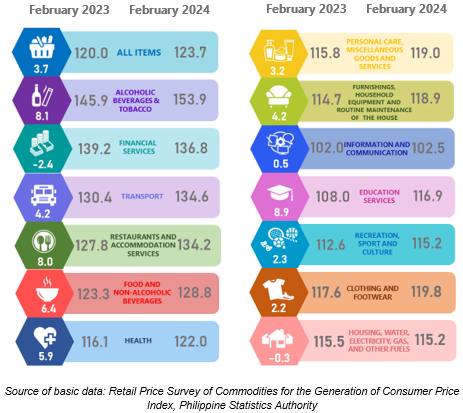
Inflation Rate
The average increase in the prices of goods and services in the region accelerated to 3.1% in February 2024, from 2.1% in January 2024. In addition, this was lower by 4.0 percentage points compared to the 7.1% inflation recorded in February 2023.
Seven (7) commodity groups in the market basket of the region posted higher inflation rates compared to February 2023. These were: Alcoholic Beverages and Tobacco (5.5%), Health (5.1%), Food and Non-Alcoholic Beverages (4.5%), Furnishings, Household Equipment and Routine Household Maintenance (3.7%), Transport (3.2%), Personal Care, and Miscellaneous Goods and Services (2.8%), and Information and Communication (0.5%).
Compared to the previous month, 2 commodity groups posted lower inflation rates. These were: Recreation, Sport, and Culture (2.3%), and Restaurants and Accommodation Services (5.0%).
On the other hand, Education Services (8.2%), Clothing and Footwear (1.9%), Financial Services (-1.7&), and Housing, Water, Electricity, Gas and Other Fuels (-0.3%) remained the same as the January 2024 inflation rates.
Among the provinces, Apayao posted the highest inflation rate in February 2024 with 6.9%, followed by Ifugao with 6.5%, and Benguet with 3.5%. Meanwhile, Mountain Province incurred the lowest inflation among all CAR provinces and HUC with 0.3%.
Figure 4. Year-on-Year Inflation Rates by Province and HUC, CAR:
February 2023 and February 2024
(2018=100)
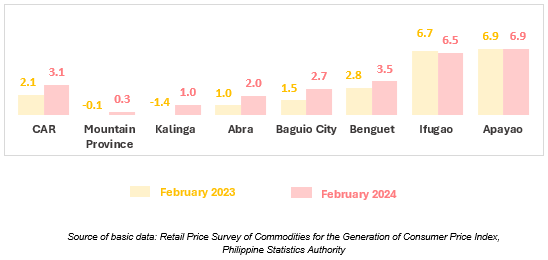
By Commodity Group
The inflation rate of the heavily weighted Food and Non-Alcoholic Beverages in February 2024 was higher by 2.0 percentage points compared to the same month of the previous year.
Alcoholic Beverages and Tobacco recorded the highest inflation rate among all commodity groups in the region with 5.5% in February 2024, followed by Health, Restaurants, and Accommodation Services and Food and Non-alcoholic Beverages with 5.1%, 5.0%, and 4.5%, respectively.
Among all commodities, the rate of Education (8.2%), Clothing and Footwear (1.9%), Financial Services (-1.7%), Housing, Water, Electricity, and Gas and Other Fuels (-0.3%) remained constant relative to the rate recorded in the previous month.
Meanwhile, Restaurants and Accommodation Services (5.0%), and Recreation, Sports, and Culture (2.3%) had lower inflation rates compared to the previous month.
Figure 5. Inflation Rates by Commodity Groups, CAR: February 2024
(2018=100)
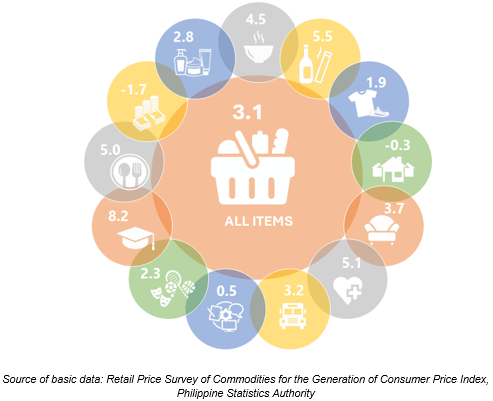
By Food Items, Year-on-Year
Among the food items, Corn recorded the highest CPI in the region in February 2024 with 184.8 index points. This was followed by Fruits and Nuts with 146.0 index points; Vegetables, Tubers, Plantains, Cooking Bananas, and Pulses with 143.3 index points; and Fish and Other Seafood with 140.0 index points.
In terms of inflation rate, Rice registered the highest rate with 22.8%, followed by Corn with 9.4%, and Fruits and Nuts with 6.6%. Meanwhile, Flour, Bread and Other Bakery Products and Ready-Made Food and Other Food Products both registered 4.8%. On the other hand, Vegetables, Tubers, Cooking Bananas and Pulses recorded the lowest rate in February 2024 with -12.4%.
Figure 6. Year-on-Year CPI and Inflation Rate of Selected Food Items, CAR:
February 2023 and February 2024
(2018=100)
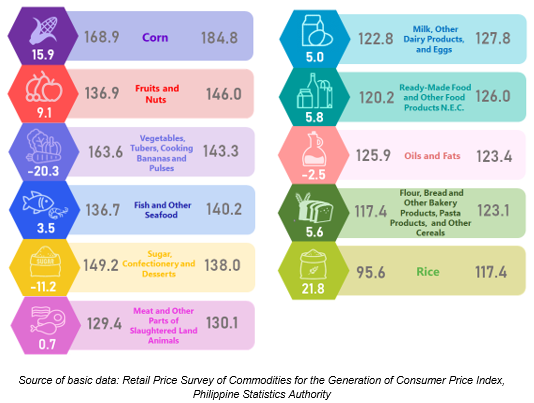
Purchasing Power of the Peso
The Purchasing Power of the Peso (PPP) in all the provinces and HUC of CAR weakened in February compared to the same month of the previous year.
The value of 1 peso in 2018 in the region was 81 centavos in February 2024. It decreased by two centavos from the 83 centavos worth of the peso in February 2023. Across provinces and HUC, Baguio City had the highest value with 83 centavos, higher than the regional value of 81 centavos. This was followed by Abra with 82 centavos and Benguet with 80 centavos. The provinces of Kalinga and Mountain Province had the same value of 79 centavos. Meanwhile, the provinces Apayao and Ifugao had the lowest peso value with 78 centavos.
In the same manner, a hundred pesos in 2018 was worth 81 pesos in February 2024.
Figure 7. Worth of a Hundred Pesos by Province and HUC, CAR:
February 2023 and February 2024
(2018=₱100)
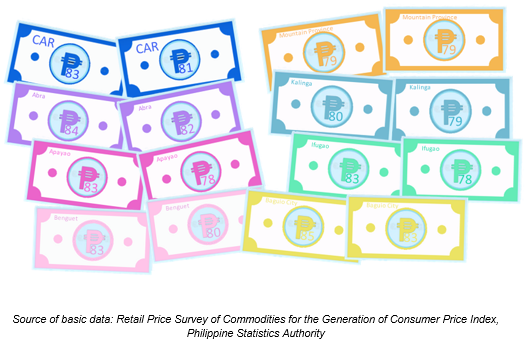
(SGD)
VILLAFE P. ALIBUYOG
Regional Director
Technical Notes
Consumer Price Index (CPI) is a general measure of the change in the average retail prices of a market basket or collection of goods and services commonly purchased by the average Filipino household.
Inflation Rate (IR) is the rate of change in the average price level between two periods (year-on-year/month-on-month as measured by the CPI).
Purchasing Power of the Peso (PPP) measures how much the peso in the reference year is worth in another year.
Base Year (BY) is the reference point of the index number series, at which the index number is set to 100. It is the reference point of the index number series.
The CPI is now rebased to 2018 base year from the 2012 base year. The year 2018 was chosen as the next base year because it was the latest year when the Family Income and Expenditure Survey (FIES) results were made available.
The rebasing of the CPI is done periodically by the PSA due to the following: 1) to ensure that the CPI market basket continues to capture goods and services commonly purchased by households over time; 2) to update expenditure patterns of households; 3) to synchronize its base year with 2018 base year of the Gross Domestic Product and other indices produced by PSA such as the Producer Price Index (PPI) for Agriculture; PPI for Manufacturing; and Value of Production Index (VaPI), Volume of Production Index (VoPI), and Value of Net Sales Index (VaNSI) for Manufacturing.
Market Basket (MB) is a sample of goods and services commonly purchased by households.

